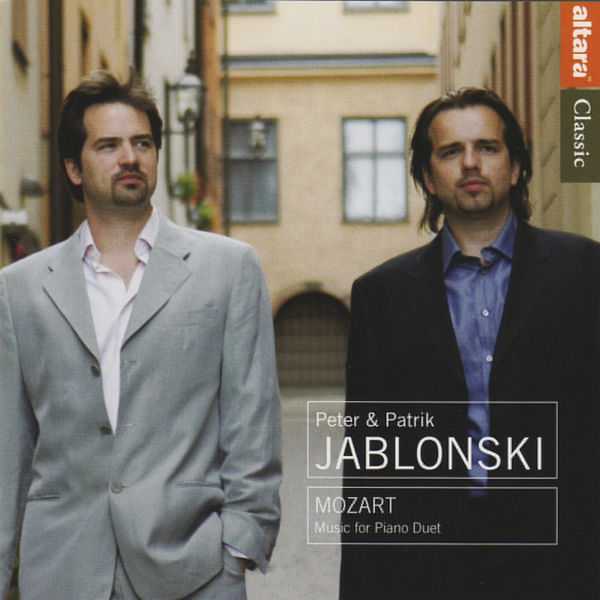
Composer: Wolfgang Amadeus Mozart
Performer: Peter Jablonski, Patrik Jablonski
Format: FLAC (tracks)
Label: Altara
Catalogue: ALT1017
Release: 2008
Size: 207 MB
Recovery: +3%
Scan: cover
01. Sonata in C Major, K521
02. Sonata in C Major, K521
03. Sonata in C Major, K521
04. Sonata In D Major, K381
05. Sonata In D Major, K381
06. Sonata In D Major, K381
07. Sonata in C Major, K19d
08. Sonata in C Major, K19d
09. Sonata in C Major, K19d
10. Sonata in B-flat Major, K358
11. Sonata in B-flat Major, K358
12. Sonata in B-flat Major, K358
Swedish duo pianists Peter and Patrik Jablonski, looking like Detective Crockett on the old Miami Vice television series, here essay a generous sampling of Mozart’s music for duo piano, including some rarely heard earlier pieces. In the case of the nine-year-old Mozart’s Sonata in C major for keyboard four hands, K. 19d, the booklet notes complain that the work is easier to play on a two-manual harpsichord than on the modern grand used, which creates “a constant danger of collisions between fingers, hands, or even elbows when reaching for notes.” Apparently this technical hurdle was surmounted, but there is tension between the music and the instrumental sound on other works on the album as well. The brothers Jablonski apply full-power piano sound to Mozart works that don’t stand up to it particularly well, having originally been written, except for the late Sonata in C major, K. 521, for a harpsichord in a chamber situation. That work is not well balanced, with purely accompanimental lines given weight out of proportion to their importance. The duo’s approach works better on the Sonata in D major, K. 381, of 1772, one of those works in which Mozart seems to use the keyboard as a dry run for symphonic thinking. And the K. 19 Sonata actually holds the listener’s attention despite the mismatch between the instrument used and the work’s original conception. Hear the irregularly shaped rondo, track 9: the performers have a knack for playing the music of the young Mozart, which requires the communication of a child’s wonder at discovering music for the first time. There are aspects of this disc that can be recommended to listeners who like high-horsepower Mozart, but they may wish to try out other models.